Thermal Transport
In school, we learn three basic modes of heat transfer: conduction, convection, and thermal radiation. For each mode, we combine constitutive laws such as Fourier’s law of heat conduction and Planck’s blackbody law of radiation with the first and second laws of thermodynamics to solve energy problems. However, these constitutive laws have limitations. We are carrying out fundamental studies to understand their limitations and developing new approaches to correctly describe transport when they fail. We combine theory, simulations, and experiments and have made exciting advances.
Phonon Transport
Phonons are quantized modes of lattice vibration and the main heat carriers in dielectrics and semiconductors. Under the Fourier law of heat conduction, however, phonons are described by a random walk picture due to frequent internal scattering. We predicted and experimentally demonstrated that heat conduction in quantum wells and superlattices (periodic multilayer structures) is dominated by scattering at interfaces, which leads to reduced phonon thermal conductivity. We pursued this effect to improve materials’ thermoelectric energy conversion efficiency via a nanostructuring approach. We also made advances in first principles simulations of phonon transport, and invented a desktop method to characterize phonon mean free distributions (other established methods require large facilities such as neutron and synchrotron sources). More recently, we have predicted and experimentally demonstrated phonon transport in the wave regime for (1) coherent heat conduction and (2) heat conduction localization. We also predicted and demonstrated heat conduction in the form of second sound near room temperature (while previous experiments were done near 10 K). Our prediction of divergent thermal conductivity in polymer chains has yet to be experimentally demonstrated.
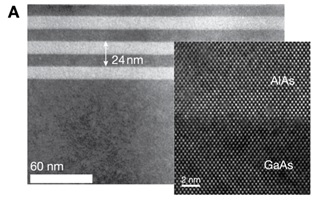 Superlattice Structure for Coherent Phonon Heat Conduction Measurement
Superlattice Structure for Coherent Phonon Heat Conduction Measurement
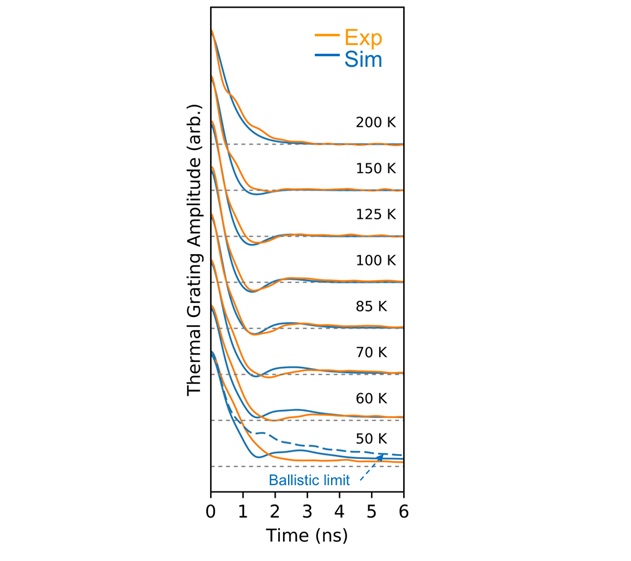 Second Sound In Graphite: Theory and Experiment
Second Sound In Graphite: Theory and Experiment
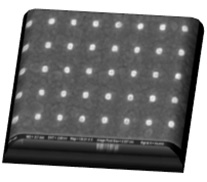 Structures Used for Phonon Mean Free Path Spectroscopy
Structures Used for Phonon Mean Free Path Spectroscopy
Key Publications
- S. Huberman, R. A. Duncan, K. Chen, B. Song, V. Chiloyan, Z. Ding, A.A. Maznev, G. Chen, K. A. Nelson, “Observation of second sound in graphite at temperatures above 100 K,” Science, 364, 375-379, 2019.
- M. N. Luckyanova, J. Mendoza, H. Lu, S. Huang, J. Zhou1, M. Li, B. J. Kirby, A. J. Grutter, A. A. Puretzky, M. Dresselhaus, A. Gossard, and G. Chen, “Phonon Localization in Heat Conduction,” Science Advances, 4, eeat9460, 2018.
- Yongjie Hu, Lingping Zeng, Austin J. Minnich, Mildred S. Dresselhaus, Gang Chen, Spectral Mapping of Thermal Conductivity through Nanoscale Ballistic Transport,” Nature Nanotechnology, 10, 701–706, 2015.
- Maria N. Luckyanova, Jivtesh Garg, Keivan Esfarjani, Adam Jandl, Mayank T. Bulsara, Aaron J. Schmidt, Austin J. Minnich, Mildred S. Dresselhaus, Eugene A. Fitzgerald, and Gang Chen, “Coherent Phonon Heat Conduction in Superlattices,” Science, 338, 936-939, 2012.
- A. J. Minnich, J. A. Johnson, A. J. Schmidt, K. Esfarjani, M. S. Dresselhaus, K. A. Nelson, and G. Chen, “A thermal conductivity spectroscopy technique to measure phonon mean free paths,” Physical Review Letters, 107, 095901 (1-4), 2011.
- G. Chen, "Thermal Conductivity and Ballistic Phonon Transport in Cross-Plane Direction of Superlattices," Physical Review B., 57, 14958-14973, 1998.
- G. Chen, "Nonlocal and Nonequilibrium Heat Conduction in the Vicinity of Nanoparticles," ASME Journal of Heat Transfer, Vol. 118, pp. 539-545, 1996.
Photon Transport
Thermal radiation is fundamentally electromagnetic waves emitted by atoms and electrons in a material. Our earth balances its energy via thermal radiation. A blackbody is considered to have the maximum ability to radiate heat, as described by the Stefan-Boltzmann Law for total emissive power and the Planck’s law for spectral emissive power. Incidentally, Planck introduced the idea of energy quantization to explain experimentally observed results on the blackbody emission, followed by Einstein who suggested the wave-particle duality of light, starting the revolution in modern physics. However, even Planck himself cautioned that the blackbody radiation law now bearing his name is not valid at small scales. We designed an experiment to measure radiation heat transfer between a sphere and a flat plate down to a separation of ~30 nm, and reported that radiation heat transfer in such small distance exceeds the Planck law by 3 orders of magnitude. More recently, we also predicted the failure of Kirchhoff’s law of radiation in magnetic Weyl semimetals via breaking electromagnetic (Lorentz) reciprocity. We are now working on near-field radiation in the near contact regime via both experiments and simulations in novel materials. In the far-field, we are designing micro/nanostructures to control emission and transmission for fabrics, windows, and roofs, aiming to reduce energy consumption. We have also worked on light trapping in thin-film photovoltaics, transparent aerogels, and selective surfaces, all based on engineering electromagnetic waves in regimes that are important for thermal radiation.
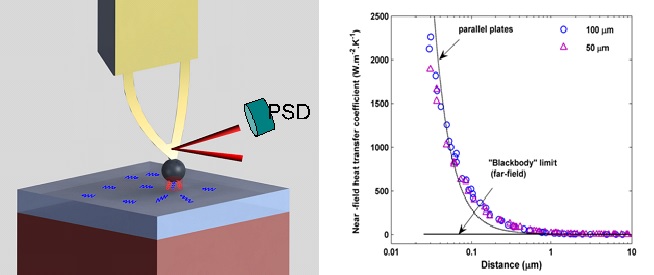 Near-Field Radiation Experiments Between A Sphere and A Plate Demonstrating Breakdown of Planck Blackbody Radiation Law
Near-Field Radiation Experiments Between A Sphere and A Plate Demonstrating Breakdown of Planck Blackbody Radiation Law
Key Publications
- Yoichiro Tsurimaki, Xin Qian, Simo Pajovic, Fei Han, Mingda Li, and Gang Chen, “Large non-reciprocal absorption and emission of radiation in time-reversal-symmetry-breaking type-I Weyl semimetals,” submitted to Physical Review B (arXiv: 1911.09600).
- Svetlana V. Boriskina, Jonathan K. Tong, Wei-Chun Hsu, Bolin Liao, Yi Huang, Vazrik Chiloyan, Gang Chen, “Heat meets light on the nanoscale,” Nanophotonics, 5, 134-160, 2016.
- Wei-Chun Hsu, Jonathan K. Tong, Bolin Liao, Yi Huang, Svetlana V. Boriskina, and Gang Chen, “Entropic and Near-Field Improvements of Radiative Cells,” Scientific Report, 6, 2016.
- Sheng Shen, Arvind Narayanaswamy, and Gang Chen, “Surface phonon polaritons mediated energy transfer between nanoscale gaps,” Nano Letters, 9, 2909-2913, 2009.
- A. Narayanaswamy, S. Shen, and G. Chen, “Near–field radiative transfer between a sphere and a substrate,” Physical Review B, 78, 115303, 2008.
- L. Hu, A. Narayanaswamy, X.Y. Chen, and G. Chen, “Near-Field Thermal Radiation between Two Closely Spaced Glass Plates Exceeding Planck’s Blackbody Radiation Law,” Applied Physics Letters, 92, 133106, 2008.
Electron Transport
What does electron transport have to do with us? Electrical transport generates heat, which is important in the thermal management of electronics, and electrons carry heat, which is the reason behind the Seebeck and Peltier effects for solid state power generation and heat pumping. These energy conversion applications motivated us to model and compute the thermeoelctric figure of merit ZT=S2σT/k, where S is the Seebeck coefficient, σ the electrical conductivity, k the thermal conductivity, and T the absolute temperature. In the process, we dived into first principles simulations of electron transport via density functional theory (DFT). The effort has led us to gain new insights into electron transport in some common semiconductors such as silicon and gallium arsenide, in addition to thermoelectric materials, and prediction of new materials such as BAs with high electron and hole mobilities.
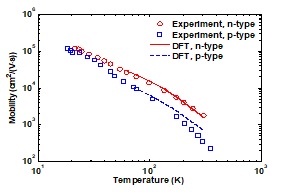 Si Mobility Simulated by DFT
Si Mobility Simulated by DFT
Key Publications
- Te-Huan Liu, Jiawei Zhou, Mingda Li, Zhiwei Ding, Qichen Song, Bolin Liao, Liang Fu, and Gang Chen, “Electron Mean-Free-Path Filtering for Improving Thermoelectric Properties in Topological Insulator SnTe,” Proceedings of National Academy of Sciences, 115, 879-884, 2018.
- Qichen Song, Te-Huan Liu, Jiawei Zhou, Zhiwei Ding, and Gang Chen, “Ab-initio study of electron mean free paths and thermoelectric properties of lead telluride,” Materials Today Physics, 2, 69-77, 2017.
- Bolin Liao, Bo Qiu, Jiawei Zhou, Samuel Huberman, Keivan Esfarjani, and Gang Chen, “Significant reduction of lattice thermal conductivity by electron-phonon interaction in silicon with high carrier concentrations: a first-principles study,” Physical Review Letters, 114, 115901, 2015.
- Bo Qiu, Zhiting Tian, Ajit Vallabhaneni, Bolin Liao, Jonathan M Mendoza, Oscar D. Restrepo, Xiulin Ruan, Gang Chen, “First-Principles Simulation of Electron Mean-Free-Path Spectra and Thermoelectric Properties in Silicon,” Eurepean Physics Letters, 109, 57006, 2015.
- Jiawei Zhou, Bolin Liao, Bo Qiu, Samuel Huberman, Keivan Esfarjani, Mildred S. Dresselhaus, and Gang Chen, “Ab initio optimization of phonon drag effect for lower-temperature thermoelectric energy conversion” Proceedings of National Academy of Sciences of the United States of America, 111, 17011-17016; 2015.
Ion and Water Transport
Driven by our work in electrochemical systems for heat to electricity energy conversion, as well as hydrogels for solar evaporation and atmospheric water extraction, we are increasingly invested in understanding ion and water transport and their thermodynamics properties. We explored ion entropy in collaboration with Professor Shao-Horn Yang. We are now understanding thermodynamic and transport of ions and waters in different materials.
Key Publications
- Botao Huang, Sokseiha Muy, Shuting Feng, Yu Katayama, Yi-Chun Lu, Gang Chen, and Yang Shao-Horn, “The role of structure making/breaking ions in electrochemical energy-conversion,” Physical Chemistry and Chemical Physics, 20, 15680-15686, 2018.